 
|
 
|
|
|
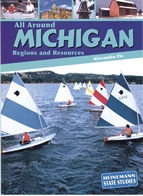
|
ALL
AROUND MICHIGAN In this colorful book the state is divided into five regions and key facts about each are discussed. Included are climate, agriculture, industry, tourism and the people which make our state so interesting. Glossary and index are included. ©2004. 7.5 x 10.25. 48 pages. Paperback. (Better 4th grade reading level and up.) II.4.LE.4
(Helps students understand the economic and cultural geography of
Michigan.) |
|||||||||
|
|
||||||||||
|
AMAZING MICHIGAN-BOOK
of PUZZLES Jeff Brown is a
master of the puzzle. Here is a unique collection of over 24 types of
puzzle activities which incorporate social studies benchmarks and
history themes. Let learning about our state be a fun experience!
Your 4th, 5th and 6th grade students will love to put their minds to
work unraveling secret codes, finding hidden words, doing word matching,
crosswords, and more! These puzzles help review Michigan history,
geography and government. I.1.LE.2 Place major events in the development of their local community and
the state of Michigan in chronological order. |
|||||||||
|
|
||||||||||
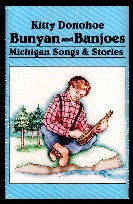
|
BUNYAN AND
BANJOES by
Kitty Donohoe
This collection of 13 traditional and contemporary Michigan songs and stories is designed for children ages preschool through grade 6, and all music-loving adults. Cassette. 35 minutes. © 1987.
1.3.1 a primary source used to reconstruct past events. |
|||||||||
|
|
||||||||||
|
EASY
ECONOMICS Helps build student confidence for the social studies MEAP. This concise reproducible booklet has 34 different activities which focus on basic economic concepts. It is divided into four sections: economic fundamentals, market fundamentals, business fundamentals, & government fundamentals. Answers to questions included. ©1998. 8.5 x 11. 54 pages. Paperback. Better 4th grade thru middle school level. REPRODUCIBLE IV.1.EE
1
Difference between goods and services. |
|||||||||
|
|
||||||||||
|
HOW A CAR
IS BUILT II.3.LE 1
cars being built in MI-location
|
|||||||||
|
|
||||||||||
|
KELLOGG'S:
GREATEST NAME IN CEREALS by William Gould Use this book based on Kellogg's cereal company in Battle Creek to help students understand the state economic benchmarks IV.4LE.l and IV.4.LL.2. Concepts such as competition, capital and human resources, consumer, investor, profit and loss are included in this interesting, bright, colorful hard cover book. The glossary helps to define the language of business. A cooperative learning activity is included at the end. ©1997. 8 x 10. 48 pages. Hardcover. (Better 4th grade reading level and up).
II.3.LE. 1 Helps students
understand how making breakfast cereal is a major economic activity in
part of Michigan.) |
|||||||||
|
|
||||||||||
|
LEARNING FROM CHARTS and
GRAPHS - Lessons in History, Civics, Geography and Economics by Jean Shafer Many students are challenged by the chart and graph elements found on the MEAP tests. Here is a way to give them practice and increase their confidence! Dr. Shafer provides 37 independent activities for 4th, 5th and 6th grade students. They are divided into four groups: Early America, America Grows, the 1900s, America Today. ©2003. 8.5 x 11.44 pages. Grades 4-6. Paperback. |
|||||||||
|
|
||||||||||
|
LEGEND
OF THE SLEEPING BEAR Produced by Sleeping Bear Press Based on the colorful book by Kathy-jo Wargin and Gijsbert Van Frankenhuyzen. An enchanting video on this famous legend. Kids can see the illustrator's art come alive with the animations used here. Narrator Jeff Daniels does a fine job bringing Kathy-jo Wargin's words to life. At the end are short interviews with the writer and illustrator. Grades K-4. ©1998. 30 Minutes. (Grades 1 - 4) |
|||||||||
|
|
||||||||||
|
LIBERTY AND JUSTICE
FOR ALL by Shirley Neitzel Provides an excellent introduction to 10 Core Democratic Values. Each value is presented in a thoughtfully written short story designed to teach its content, meaning, and significance. The illustrations are visually appealing. A separate 32 page teacher's guide has reproducible activity sheets which offer helpful preparation for the social studies MEAP. ©2002. 8.5 x 11. 48 pages. Paperback. Grades 3-5. (Reading level grade 4)
III.2.LE 2 interpret the meaning of rights guaranteed by |
|||||||||
|
|
||||||||||
|
LITTLE
PEOPLE'S BEGINNING ON MICHIGAN by McConnell, Parker & Deeter A Popular way to
introduce first and second graders to several of the early elementary
social studies benchmarks! A great start to a lifelong adventure of
discovering Michigan. Learn about our shape, where we are, the two
peninsulas, the Great Lakes, Mackinac Bridge, the state capital, our
resources and products, our state symbols and the state flag. 2002
edition. 8.5 x 11. 28 pages. Paperback. ll.1.EE
1 (Helps young students describe some of the human characteristics Michigan and explain some of the basic causes for those characteristics.) |
|||||||||
|
|
||||||||||
|
||||||||||
|
|
|||||||

|
MICHIGAN BINGO GAME |
||||||
|
|
|||||||
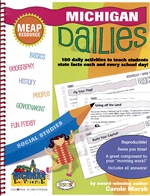
|
MICHIGAN DAILIES 180 Activities for Kids by Carole Marsh One quick reproducible activity for each day of the school year. Use as a sponge activity to fill in free moments during the day. Well suited for 4th grade. Each activity focuses on Michigan. Examples are: our fruit belt, the Mackinac Bridge, settlers using the Erie Canal. ©2006. Spiral bound. REPRODUCIBLE. (These short activities are a good review of numerous social studies later elementary level benchmarks from the historical, geographical and civic perspectives.) |
||||||
|
|
|||||||
|
|||||||
|
|
|||||||
|
MICHIGAN NATIVE PEOPLES by Marcia Schonberg Learn about Native American traditions, clothing, food and tools. Meet the leaders Matchekewis, Okemos, Pokagon, Pontiac and Tecumseh. Find out about the effect of European influence. See the list of federal and state recognized tribes and a map of current tribal lands. Glossary and index. ©2004. 7.5 x 10.25. Paperback. 48 pages. (Better 4th grade reading level and up.) I.2.LE.1 (Helps
students summarize the sequence of key events in the history of
Michigan's Native Americans.) |
||||||
|
|
|||||||
|
MICHIGAN PLANTS AND ANIMALS by Marcia Schonberg. A nice single book resource to help students meet benchmark !!.LE4.5. Very colorful. Shows and describes Michigan forests, Great Lakes, sand dunes, beaches, inland lakes, rivers, streams, swamps, marshes and wetlands. Extinct plants and animals, endangered plants and animals and the effects on the ecosystem are all included. Glossary and index included. ©2004. 7.5 x 10.25. Paperback. 48 pages. (Better 4th grade reading level and up.) II.2.LE.1
(Helps students understand ecosystem concepts and processes in a
Michigan setting.) |
||||||
|
|
|||||||
|
|
|||||||
|
|
|||||||
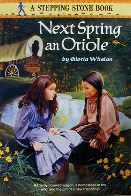
|
NEXT
SPRING AN ORIOLE The first in a sequel of three books about young pioneer Libby Mitchell who moves to Michigan in a covered wagon when she is 10 years old. The story begins on April 3, 1837. Once she arrives in Michigan, Libby meets Taw cum e qua who is later known as Fawn. Fawn is a Potawatomi girl who becomes her best friend. Libby learns much about the fate of this tribe who will soon be forced off their land. ©1987. 5.25 x 7.5. 60 pages. Paperback. (Reading level about 4th grade.) I.2.LE.1
(sequence key events from the history of Michiganís Native Americans) |
||||||
|
|
|||||||
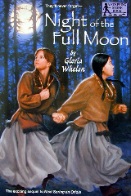
|
NIGHT OF
THE FULL MOON A story about two girls during the time the Michigan tribes were forced to move west. One is a settler and the other Potawatomi. Helpful in meeting the later elementary benchmarks I.4.LE.1, II.5.LE.2 and III.1.LE.2. ©1993. 6 x 9. 62 Pages. Paperback (Grades 3-5) |
||||||
|
|
|||||||
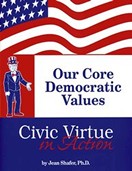
|
OUR CORE
DEMOCRATIC VALUES by Jean Shafer Help prepare for the
social studies MEAP. This concise reproducible booklet has 19 different
activities. Helps students understand the importance of these values in
our society. It concludes with tips for teaching and a list of
trade-books which support the various values. Answers to questions
included. ©
1999. 8.5 x 11.28
Pages
|
||||||
|
|
|||||||
|
PADDLE-to-the-SEA This classic has received renewed interest because of the whole language approach to teaching Michigan studies in the elementary grades. Paddle-to-the-Sea provides initial introduction to major social studies conceptsó geography, ecology, economics, and more. Students will be enthralled by the Soo Locks, forest fires, and shipwrecks. Very nice color illustrations. ©1941. 8.5 x 11. 64 Pages. Paperback. Grades 2-5 (Reading level grade 4.5-5)
|
||||||
|
|
|||||||
|
PADDLE-to-the-SEA Class-room-ready readings, worksheets, games, diagrams and complete instructions for teach use. Integrates social studies, math, science and language arts. ©1987. 8.5 x 11. 168 Pages in a 3 ring binder.
|
||||||
|
|
|||||||
|
PEOPLE OF MICHIGAN by Marcia Schonberg Begins with information on our people in general - where we live and our ethnic backgrounds. Brief sections on the Native Americans, French explorers, missionaries and settlers. Short biographies tell about several of the states' outstanding people. Index and glossary for easy reference. ©2004. 7.5 x 10.25. Paperback. 48 pages. (Better 4th grade reading level and up.) I.2.LE.3 (Provides
students with information of the lives and characters of a variety of
individuals form Michigan's past and present) |
||||||
|
|
|||||||
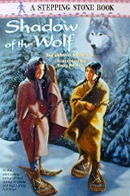
|
SHADOW
OF THE WOLF The third book in the sequel about the Michigan pioneer girl Libby and her Native American friend Fawn. It is only 1841 but Libby and her parents already begin to feel hemmed in by the ever increasing number of settlers. They decide to move north to the forests along Lake Michigan. Soon Fawn and Libby discover greedy men trying to cheat the tribe out of the little land they have left! ©1997. 5.25 x 7.5. 80 pages. Paperback. (Reading level about 4th grade). I.4.LE.1
(problems from the past that divided communities) |
||||||
|
|
|||||||

|
TRAIN TO MIDNIGHT by Janie Lynn Panagopoulos A fine story to help elementary level students learn about the Underground Railroad. Malaika and Samson have been separated from their mother and alone must make their way north to freedom. © 1999 6 x 9. 179 Pages. Paperback. Reading level about 5th grade.
|
||||||
|
|
|||||||

|
TWO
PENINSULAS CALLED MICHIGAN Video by Vince Deur Productions A very professional full color video with spectacular scenery. This video covers all the basics about Michigan, its two peninsulas and the Great Lakes. The narrative informs the viewer of the famous attractions of Michigan such as Mackinac Island, Pictured Rocks, Sleeping Bear Dunes and many more. A great addition for teaching Michigan studies to any 3rd or 4th grade classroom. © 1996. (4th grade and up) Available in VHS & DVD 18 minutes. II.2.LE.3 describes major
physical patterns, ecosystems, resources and land uses of the state. |
||||||
|
|
|||||||
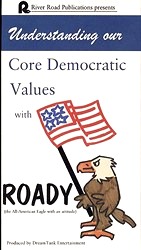
|
UNDERSTANDING OUR CORE DEMOCRATIC VALUES Video by Dream Tank Entertainment Are your kids struggling to grasp the values which built our nation? Join this video classroom and hear the teacher and students discuss 10 core democratic values. Justice, Popular Sovereignty, Common Good, Life, Pursuit of Happiness, Liberty, Equality, Diversity, Truth and Patriotism are explained using 3rd and 4th grade life examples. Roady, an eagle puppet aids in the discussion. © 2001. (3rd to 4th grade) VHS 19 minutes.
|
||||||
|
|
|||||||
|
UNDER
THE QUILT OF NIGHT Dramatic, well-done illustrations show the suspense of slaves escaping on the Underground Railroad. A slave girl tells about the hideouts, people who help along the way and the codes provided by the special quilts hanging out to air. Short, simple text n each page. A great book for a read-to-me story session. ©2002. 8.75 x 11.25. 32 pages. Hardcover. (Better 3rd-4th grade.) I.
2. LE. 2 (Helps students compare life in the past in Michigan and other
parts of the nation with life today.) |
||||||
|
|
|||||||
|
WALK
THROUGH TIME at the Michigan Historical Museum by former Secretary of State Candice S. Miller Here is a great video to introduce your class to the museum before your school trip to Lansing! This video provides an overview of Michigan history and quick glimpses of some of the museum displays. ©2002. 30 minutes. (Grade 3 and up). I.
3. LE. 3
(Helps students compose narratives of events from Michigan
history.) |
||||||
|
|
|||||||
39 North Street Hillsdale, MI 49242 - Phone: (517) 437-3179 Fax: (517) 437-0531 |